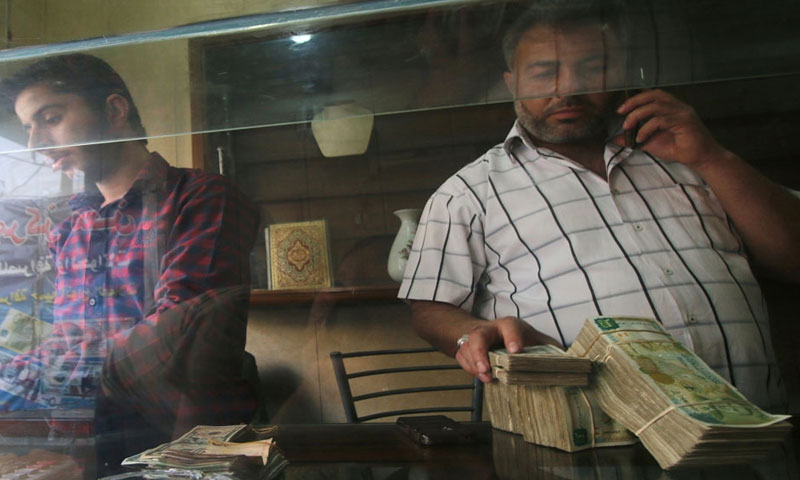In an acknowledgement of inflation, the Syrian Central Bank is reportedly issuing a new 5,000 pound banknote writes Enab Baladi
Less than a year after the Syrian Central Bank issued a new financial note for 1,000 Syrian pounds, and the negative effects it had on local currency, there is now talk of issuing a new note — one for 5,000 Syrian pounds.
This comes after a draft law in parliament on May 9 stipulating the amending of Article 16 of the Central Bank law, to allow it to issue financial notes from 1,000 to 5,000 pounds.
Despite the discussions, currently being limited to a draft law without the currency being printed, repeated denials were made by the Governor of the Central Bank Duraid Durgham that the new denomination was being issued, the latest of which was on April 10.
At the time he told the official SANA news agency that “the rumors are part of the continuing campaign to distort the gains made by the Syrian economy and the results of the financial policy that has achieved relative stability in the pound.”
Discussion of the new note have inspired reactions among Syrians and created tension among a segment of them who said that the new denomination, considered the largest in Syria’s history, is evidence of the beginning of the pound’s collapse. Questions have been asked about what impact the new note could have on the pound’s future and the increase of prices, which required a response from the Central Bank.
Durgham said on Facebook that issuing a new note would take a long time and would be undertaken and the right time, which would be decided upon depending on the economic activity and done in a way that guarantees the various interest of those dealing in the pound.
However the economic researcher Yunes al-Karim told Enab Baladi that a 5,000 pound note had previously been printed in Russia but only in small quantities. He said that the printing had been done by the previous governor Adib Mayala in 2012, who had tried to create what Karim described as “the Syrian or local dollar”, meaning a printed note at a value of 100 dollars, which would end dealings in the dollar with the aim of strengthening the Syrian economy. (In 2012, 5,000 Syrian pounds equaled 100 dollars at a value of 50 pounds to one dollar).
The deputy finance minister in the Syrian Interim Government, Abdel Karim al-Masri, said that the new currency was still a draft law that needed study and agreement and the printing would be ordered in a year or two.
He told Enab Baladi that it was natural for there to be large notes, after the pound lost more than 85 percent of its value, in order to ease transactions, in addition to the price of printing going down. Printing five 1,000 pound notes is more expensive than printing one 5,000 pound note.
The government is printing new notes to fund the general state budget deficit. If there is a deficit in the budget it prints notes without providing any balance or production against this currency.
The Syrian budget as announced by the cabinet for 2018 has a deficit of 799 billion pounds, according to Masri, who said that from the start of the revolution until now, there has been an accumulating deficit of about 3.973 trillion pounds, and so the regime wants to issue a new note without covering the productivity or balance of foreign currencies or gold.
Negative Impact on the Citizen
The Central Bank governor justified issuing the currency by saying that the larger denominations are appropriate as they ease transactions and make counting, transport and other operations smoother. He added that economic activity will return to Syria in the coming years and it needed to print denominations that were appropriate for the future economy.
Karim said that Durgham was correct in principle but that the implementation was wrong because people did not deal in pounds except with government agencies, while major transactions were in dollars.
Masri said that the bank’s justification was unacceptable and that it was a type of “positive media propaganda” and while it was possible for the new note to help ease transactions, and that this was positive, the loss of value of the Syrian pound was not a positive step, which is compounded by there being a major deficit in the budget without the production.
Regarding the impact of the currency if it is issued, Masri said that it would lead to major inflation and a reduction in the price of the pound and perhaps its collapse if it does not arrive with an increase in production or reserves in terms of hard currency or gold — and this was not currently possible because the Syrian government’s trade balance was negative, as well as being majorly in debt to Iran and Russia and therefore it was certain to reduce the value of the pound and raise prices.
Karim said that printing the new larger denomination would take small denominations, like the 25, 50 and 100 pound notes, out of circulation. Transactions would only be in 200, 500 or 1,000 pounds, while the issuance would increase inflation because it is funding a budget deficit that has accumulated for five years and will be accompanied by major price rises, which will negatively impact the citizen wherever he is, whether in regime or opposition-controlled areas.
This article was translated and edited by The Syrian Observer. Responsibility for the information and views set out in this article lies entirely with the author.











